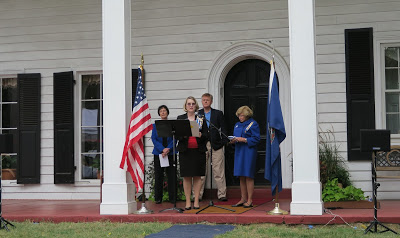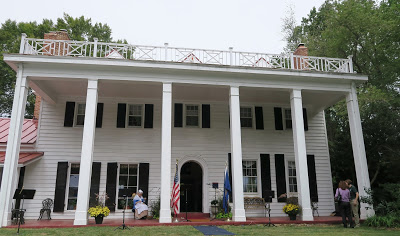DAR presents historic plaque to Oak Hill
 |
| The dedication ceremony of a historic plaque at Oak Hill featured, from the left: Sharon Bulova, chair of the Fairfax County Board of Supervisor; Lise Harvey, regent of the Anna Maria Fitzhugh Chapter of the DAR; Braddock Supervisor John Cook; and the chapter’s chaplain, Jeannie Leson. |
A plaque recognizing the history of Oak Hill, the oldest house in Annandale, was unveiled Sept. 26 during Oak Hill Day by the Anna Maria Fitzhugh Chapter of the Daughters of the American Revolution (DAR).
Oak Hill Day is the one day of the year when the house is open to the public. This year, there were several presentations on the history of the house and music from the revolutionary period performed by the U.S. Army Old Guard Historical Trumpets & Flutes.
 |
| The portico and columns were added to Oak Hill in the 1930s. |
The open house is required under a historic and conservation easement approved in 2004, which also calls for the owners, currently David and Amanda Scheetz, to maintain the historic integrity of the house and property.
During the dedication of the historic marker, Lise Harvey, regent of the Anna Maria Fitzhugh Chapter, spoke about how the DAR spent years compiling the documentation, with help from historians, to meet the requirements for an official plaque.
The plaque, attached to the house next to the front door, states:
“Oak Hill, built circa 1790. Oak Hills is the last remaining Fitzhugh manor house on the original Ravensworth Tract. President Thomas Jefferson spent several nights here en route to Monticello from Washington. Extensive renovations in the popular Colonial Revival style were made in the 1930s and 1940s under the direction of prominent restoration architect Walter M. Macomber. Marker placed by Anna Maria Fitzhugh Chapter, NSDAR, 2015.”
 |
| The U.S. Army Old Guard Fife & Drum Corps. |
Oak Hill was built by Richard Fitzhugh on land he inherited from his great grandfather, William Fitzhugh, a member of the House of Burgesses. The land was part of the nearly 22,000-acre Ravensworth Tract and had already been the site of a large tobacco plantation, says Liz Crowell, manager of the Cultural Resource Management and Protection Branch of the Fairfax County Park Authority. Many of the huge boxwoods on the property were planted in the 1790s.
Richard, his wife Suzanna, and their eight children lived on and managed the Oak Hill plantation with slave labor and at least one tenant farmer. In 1889, Oak Hill passed out of the Fitzhugh family and William Watt, an immigrant from Scotland, purchased the house and 600 acres for $900.
 |
| Annandale High School culinary students and teacher Christine Gloninger (second from left) hand out cookies at Oak Hill Day. |
Richard and Jane Howrey bought the house in 1931. They hired Walter Macomber who restored the house in the Colonial Revival style, which was popular at the time. That’s when the third story with dormer windows and front portico with columns were added, giving the house an appearance like Mount Vernon.
Later owners further renovated and expanded the house. It now has five and a-half bathrooms and central air conditioning. When the Scheetz’s bought Oak Hill in 2008, they took out a swimming pool that had been added in the 1970s and created a colonial-era garden on that spot.
David Scheetz, a civil engineer interested in history, says he was driving along Wakefield Chapel Road when he saw a sign advertising a historic house for sale and eventually convinced Amanda, a music teacher, to take a chance on it. “We feel really privileged to be able to live here,” she says.
 |
| Oak Hill owners David and Amanda Scheetz (center) with Supervisor John Cook and BoS Chair Sharon Bulova. |
David thinks some of the wavy window glass might be original because it looks like someone had scratched a message on one of the panes, although it’s not legible. During colonial times, he says, it was customary for new brides to use their wedding rings to write something on a window.
There was an incident at Oak Hill during the early part of the Civil War known as the “kitchen skirmish,” he says. A couple of Union scouts came to the property and were shot and wounded by residents of the house.
Living in an old house is difficult. All three chimneys fell down during the 2011 earthquake, David says. Leaky pipes caused water damage, and the sewers backed up when a tree root grew into the sewer line.
Aside from the physical challenges, there are metaphysical incidents. Amanda has heard strange footsteps on the stairs at night when no one was there and recently she and David discovered small objects have mysteriously moved. Items on the mantelpiece in a guest bedroom have been turned sideways, for example. And at one point, there was a strong odor of gunpowder in a third-flood bathroom.
 |
| Don Williams, a volunteer with the Burke Historical Society, and Helen Anderson, wearing a linen everyday outfit like those worn by the first residents of Oak Hill in the 1790s. |
They don’t feel threatened by the those incidents, Amanda says. She believes the ghost, possibly Ann Fitzhugh, “is happy we’re here to take care of the house.”
According to legend, Ann’s father took her to London before the American Revolution, where she fell in love with Charles Hawkins, a captain in the British Army. Hawkins was later sent to America to put down the rebellion and while in the colonies visited Ann at Oak Hill. During one visit, the Continentals were tipped off that Hawkins was there and demanded to search the house. Hawkins and Ann were hiding in a secret room over the dining room. The captain escaped, but one of the soldiers thrust his bayonet into the trap door in the ceiling, killing Ann.
Since then, people have reported seeing a blood stain in the ceiling and hearing the sound of boots on the stairs. Others doubt the story even happened since Oak Hill wasn’t built until after the American Revolution.

Where Penny be at?
Not in Mason District. But good try. Any chance to take a shot at our Supervisor, right?
I wonder if the NIMBY Penny Haters have any lives outside of their obsession with Penny….would make for a good case study.
Where did they say they hated Penny??? Seems like you're the one focused on your imagined Penny-hate.
5:03, you must be new to this site.
Where Mollie be at? Her "community outreach" is limited to the 1 percenters that live in Sleepy Hollow.
Penny was actually partially responsible for the demolition of the Fitzhugh-Thomas house in 2010 (which was in Mason District). It's historical importance was probably not that high, but Penny's office did privately "expedite" the developer's plan that had repeatedly failed to pass the County's site plan review phase. The resulting infill cluster development left the surrounding neighborhood with a deficient stormwater plan, but the County got a small bump in tax base.